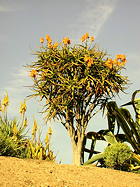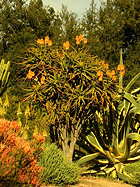Considerable excitement was generated among aloe collectors about ten years ago by word of availability of A. eminens. This arborescent, red-flowered, Somalian species had never been accessible to most aloe enthusiasts, and that remains the situation today. However, the true identity of the impostor tree aloe proved to be equally worthy to horticulture.
We received two six-foot specimens from Chula Vista nurseryman, Kevin Coniff, in 1994. He had acquired his parent stock from Manny Singer who said his original seeds came from John Lavranos. When Lavranos visited the Huntington in Sept 1994, he identified the plants from Coniff as the Mozambique form of A. bainesii, now considered a synonym of A. barberae.
Paul Hutchison of Tropic World Nursery had been sufficiently impressed by Coniff’s plants that he had apparently drafted a formal description under the name “Aloe medusa” (pers. comm.). That manuscript is yet to be cataloged among the Hutchison papers donated to the Huntington prior to his death. In addition to this form’s more human scale (under 3 m for us though Conniff reports plants to 6 m after 20 years or more) it also has more compact inflorescences of pastel orange buds (yellow in shade) that open pale pink rather than the more uniform pink of larger tree forms widely grown in cultivation. It also tends to flower about a month earlier, in December.
According to Lavranos, the seed he originally sent to Singer was collected NNE of Maputo, along the coast E of Vila Luisa, Mozambique. Our seedlings are from controlled pollination of the two Coniff plants (HBG 77301 and 77302). $15.
This plant from northern S. Africa and southern Mozambique has been considered to be merely a coastal form of the more widespread A. barberae. It has been circulating for a number of years as the “medusa form” or even under the unpublished Aloe medusa. It has now been published as a separate species, Aloe tongaensis van Jaarsveld, in Aloe 47:3(2010) and was discussed in the prior issue of this journal in van Jaarsveld’s article on tree-aloes. The species is distinguished from A. barberae by its earlier flowering-period (late autumn to early winter vs. midwinter) and its distinctive flowers (longer and yellowish-orange vs. pinkish).

Published in the Cactus and Succulent Journal, Vol. 77 (2), March - April, 2005

